
Ivor Markman
The Trojan Horse Shootings

PAINFUL MEMORIES: Almost 25 years after her son, Michael Miranda, was shot dead in 1985 by a special Railway Police task force, Georgina Williams visited the monument in April 2010, at the scene of the shooting in Thornton Road, Athlone.
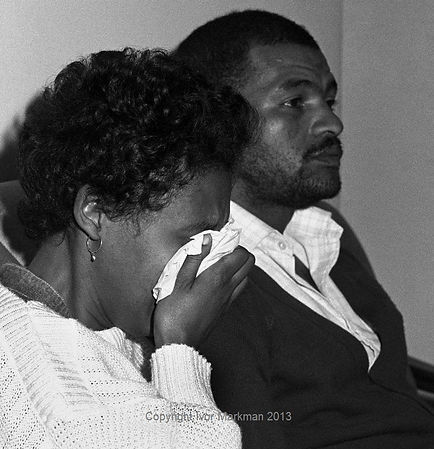
GRIEVING MOTHER: Georgina and Theophilus Williams had just found out that their son, Michael Miranda, 11, was one of three young boys shot dead by police in Thornton Road in October 1985. This photo was taken the day after the shootings.
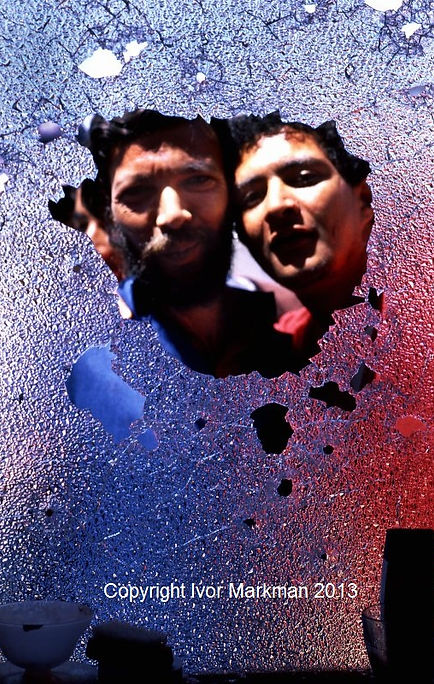
THORNTON ROAD: Athlone resident Hasim Saidow and a friend peer through a hole in a window on October 16, 1985. The hole was created by bird shot fired by members of the Railway Police special task force during the infamous Trojan Horse shooting when three youths were shot dead.
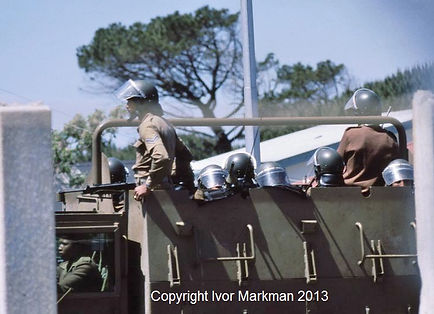
RAILWAY POLICE: After the previous photo was taken the two men quickly scattered when they saw a Caspir approaching. Seconds later another photo was taken though the same hole as railway police in a Buffel armoured vehicle drove past and opened fire with their shotguns, hitting another young man.
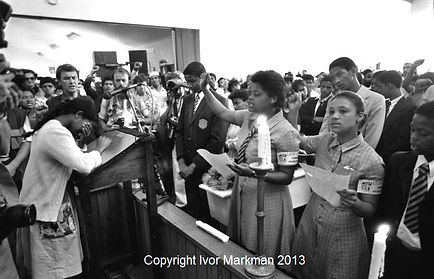
HEARTBROKEN FRIEND: While delivering the eulogy for the three young boys killed during the infamous “Trojan Horse” shootings in Athlone four days previously, this young girl burst into tears. Railway Police were hiding in wooden crates and jumped up, opening fire upon unsuspecting protesters.
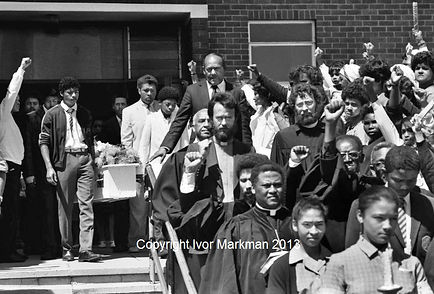
BLACK POWER SALUTES: Priests, scholars and friends give black power salute as the coffins of the young victims of the infamous “Trojan Horse” shootings exited the church following the memorial service.
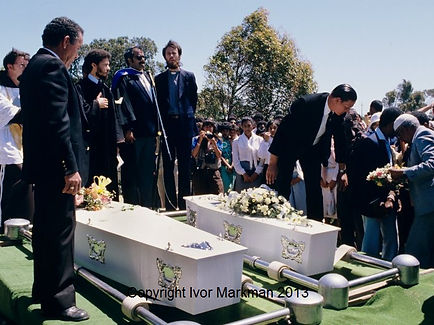
FINAL GOOBYES: The white coffins of two of the young victims of the Trojan Horse shooting are prepared for burial.
Ivor Markman
On October 15, 1985, 25 years ago - and 11 days after Prime Minister P W Botha declared a state of emergency - a seemingly innocent looking truck belonging to the South African Transport Services drove through the Cape Town suburb of Athlone carrying wooden crates on the back,.
The truck followed a route which twice brought it up Thornton Road.
As it approached a crossroad, a group of 200 protestors, thinking the truck was a safe target, pelted the truck with a hail of rocks.
To their surprise, a group of shotgun-armed policemen, jumped up from inside the crates and, without warning, opened fire on the crowd.
Three young people were shot dead - Michael Miranda, 11, Shaun Magmoed, 16, and Jonathan Claasen, 21.
Two of them were killed in the road and the third in a nearby house.
The incident, captured by a CBS film crew, immediately became known as 'the Trojan Horse shootings' and was relayed around the globe to a shocked international audience.
It took three years before an inquest was held in February, 1989, to investigate the circumstances of the shooting.
Police claimed they were ordered to conceal themselves in the boxes and defended their action by saying it was a necessary technique to protect people using public roads.
But for Georgina Williams, mother of Michael Miranda, it was the start of a traumatic era from which it took years to emerge.
For her the day of the shooting started off as just a normal day.
The previous night she had put out the clothes Michael was to wear when he came home from school - an orange and navy checkered shirt and navy-blue tracksuit trousers.
The family rose early that fateful morning.
Her brother picked her up and give her a lift to work at quarter to seven.
Georgina worked as a machinist manufacturing jeans in a clothing factory, New Name Clothing, at the corner of Buitenkant and Commercial Streets, in downtown Cape Town.
As was his habit, Michael took his eight-month-old sister to their neighbour, who minded the kids until Georgina returned home from work in the afternoon.
“That morning Michael took my baby over to my neighbour,” said Georgina, recalling the backward glance and smile on his face.
"Bye, mommy,” he said.
“I still remember that,” said Georgina. “That was the last I saw of him.
“Then I went to work. It was quite a normal, ordinary day for me."
Later in the day Georgina heard about the riots but she was not too concerned as she thought her children were safe with her sister.
“At the time the riots were (happening) during the day. I (told Michael) if there's riots he must come home, go inside or go to the neighbour who minds my baby,” she said.
Georgina had also asked her invalid brother and Michael’s uncle, Victor Miranda, to take Michael and Claudia over to her sister, Cheryl Thieunissen's home in the event of riots.
At nine o’clock in the morning the riots started so Victor took the two children to Cheryl.
While Michael was there, Cheryl’s son, Salie, 13, decided to go sell some pigeons.
“He took two pigeons in a box and took Michael with him. That's (how) they landed up in Thornton Road,” said Georgina.
“When Salie was shot he turned around and ran.
"When he collapsed someone pushed him in a car and drove him to hospital.
"He couldn't speak (because) he was in hospital having his operation,” she said.
When she arrived home she knew nothing of the events that day.
“Round about half past five (or) six o'clock, I asked my brother to go and fetch the kids,” said Georgina.
“He came back and told me Salie was shot but they didn't know where Michael was.
“Then I thought, if Salie is shot, maybe Michael ran away or went to hospital with Salie.
“We waited till about eight o'clock. Then my sister phoned from hospital saying that Salie was serious,” she said.
She asked if Michael was at home.
“That's when I started to worry,” said Georgina.
She then went to check at the police station, thinking Michael might have been thrown into one of the police Caspirs.
Once there she heard rumours about police arresting children.
“We waited there for a while. Then they brought out the guys they arrested to the front.
“The police station was packed. I was on the counter, hanging over, because I wanted to see a small boy, not a big guy.
“He wasn't there,” she said.
One of the policeman then announced to the crowd there was a child in the morgue.
“Then I got worried. The atmosphere was so tense,” she said.
Even though the policeman announced there was a child in the morgue, Georgina still didn’t think it could be her son.
“When the shooting started, people opened their doors and took in the kids (who were) in the roads. He was a very nervous child, he wasn't a naughty child.
"I thought he was scared to come out, it was not my child, . . . it couldn't be Michael.
“I thought Michael (had been) somewhere else and maybe he’d come home (by then),” she said.
She went home to see if Michael had arrived home.
At nine o’clock she went to Thornton Road.
People were standing around and she asked if anyone had seen any sign of him but she couldn't get past the police standing in the road.
At 11 pm she went to the home of another sister, Aashia du Toit, to enquire if Michael was perhaps with them, but he was not.
Then Cheryl phoned her from Groote Schuur hospital to tell her Salie had undergone an emergency operation.
He had been hit in the neck and chest with birdshot.
Georgina never slept that night.
The next morning Cheryl’s husband, Ishmael, was at hospital when he heard over the security desk radio the unidentified body of a boy, who was shot in Athlone, was at the Groote Schuur Hospital morgue.
He phoned Georgina to ask if Michael had returned home. When she replied in the negative, he decided to pay a visit to the morgue.
When Ishmael arrived at the morgue he asked if the relatives of the unidentified boy had been to identify the body.
He was told they had not been there.
They asked if he wanted to view the body. He replied in the affirmative and he was taken behind a screen.
That was when he found Michael.
“I was getting ready to go to the school to tell the principal (Michael) didn't come home, (when Ishmael arrived),” said Georgina.
“He said he found Michael (and) asked what Michael had on,” said Georgina.
“He took me to the morgue and I saw Michael. He was shot in the face. Two pellets went into his forehead, that's what killed him.
“There were a lot of other pellet marks on his face,” she said.
There was a huge gap on the side of his nose.
“You could see his back teeth,” said Georgina.
“His head was swollen, quite a lot. When I looked at him I wasn't quite sure (if it was) my child. He was so big, laying there.
“But when I just looked at him, I could see (it was him) because his hair made a crown. It was there,” she said.
Georgina was never informed of Michael’s death by the police.
“Nobody came to me, nobody,” she said.
“At the funeral I never wanted to cry. I wanted to cry but I rather kept it in because of the cameras. I was like a walking time bomb.
“During the inquest my boss wasn't really interested in my case. (I was just) another worker not coming to work so (the time away) was subtracted from my wages.
“The youth were my support. I didn't know them. Sometimes I didn't want them there but they just kept on coming.
“There were days when I didn't have (any money). They would organise a carrier of groceries for me, or bring me R20 on a Saturday afternoon.
“With the Truth Commission, I met a lady (who) was wonderful. She helped me through this.
"The day I appeared before the Truth Commission, when it was all done, I just let it out.
"I had to carry that for 10 years (but) I'm free of it now,” said Georgina.
Text: Copyright Ivor Markman 2013.

